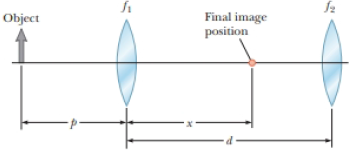
Concept explainers
Two converging lenses having focal lengths of f1 = 10.0 cm and f2 = 20.0 cm are placed a distance d = 50.0 cm apart as shown in Figure P35.48. The image due to light passing through both lenses is to be located between the lenses at the position x = 31.0 cm indicated. (a) At what value of p should the object be positioned to the left of the first lens? (b) What is the magnification of the final image? (c) Is the final image upright or inverted? (d) Is the final image real or virtual?

(a)
Answer to Problem 36.78AP
Explanation of Solution
Given info: The focal length of first lens
Write the expression for the final image distance
Here,
Substitute
Write the expression for the thin lens equation.
Here,
Substitute
The image distance to the first lens
Here,
Substitute
Formula to calculate the thin lens equation is,
Here,
Substitute
Conclusion:
Therefore, the value of
(b)
Answer to Problem 36.78AP
Explanation of Solution
Given info: The focal length of first lens
Write the equation for magnification of the first lens.
Write the equation for magnification of the second lens.
Write the equation for magnification of the final image.
Substitute
Substitute
Conclusion:
Therefore, the magnification of the final image is
(c)
Answer to Problem 36.78AP
Explanation of Solution
Given info: The focal length of first lens is
Here, the value of magnification of the final image is
If the magnification is found to be negative
Thus, the image formed is an inverted image.
Conclusion:
Therefore, the final image is inverted.
(d)
Answer to Problem 36.78AP
Explanation of Solution
Given info: The focal length of first lens is
Here, the value of final image distance is
If the value of final image is found to be negative
Thus, the image formed is a virtual image.
Conclusion:
Therefore, the final image is virtual.
Want to see more full solutions like this?
Chapter 36 Solutions
EBK PHYSICS FOR SCIENTISTS AND ENGINEER
- Math 57arrow_forwardPoint charges q1 = 50 µC and q2 = −25 µC are placed 1.0 m apart. What is the magnitude of the force on a third charge q3 = 40 µC placed midway between q1 and q2? (The prefix µ =10−6 C.)arrow_forwardThe de-excitation of a state occurs by competing emission and relaxation processes. If the relaxation mechanisms are very effective:a) the emission of radiation is largeb) the emission of radiation is smallc) the emission occurs at a shorter wavelengthd) the de-excitation occurs only by emission processesarrow_forward
 Physics for Scientists and EngineersPhysicsISBN:9781337553278Author:Raymond A. Serway, John W. JewettPublisher:Cengage Learning
Physics for Scientists and EngineersPhysicsISBN:9781337553278Author:Raymond A. Serway, John W. JewettPublisher:Cengage Learning Physics for Scientists and Engineers with Modern ...PhysicsISBN:9781337553292Author:Raymond A. Serway, John W. JewettPublisher:Cengage Learning
Physics for Scientists and Engineers with Modern ...PhysicsISBN:9781337553292Author:Raymond A. Serway, John W. JewettPublisher:Cengage Learning Physics for Scientists and Engineers: Foundations...PhysicsISBN:9781133939146Author:Katz, Debora M.Publisher:Cengage Learning
Physics for Scientists and Engineers: Foundations...PhysicsISBN:9781133939146Author:Katz, Debora M.Publisher:Cengage Learning Principles of Physics: A Calculus-Based TextPhysicsISBN:9781133104261Author:Raymond A. Serway, John W. JewettPublisher:Cengage Learning
Principles of Physics: A Calculus-Based TextPhysicsISBN:9781133104261Author:Raymond A. Serway, John W. JewettPublisher:Cengage Learning College PhysicsPhysicsISBN:9781305952300Author:Raymond A. Serway, Chris VuillePublisher:Cengage Learning
College PhysicsPhysicsISBN:9781305952300Author:Raymond A. Serway, Chris VuillePublisher:Cengage Learning College PhysicsPhysicsISBN:9781285737027Author:Raymond A. Serway, Chris VuillePublisher:Cengage Learning
College PhysicsPhysicsISBN:9781285737027Author:Raymond A. Serway, Chris VuillePublisher:Cengage Learning





